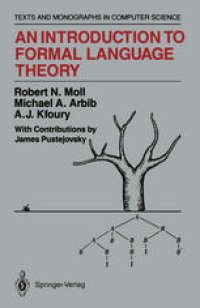
Ebook: An Introduction to Formal Language Theory
- Genre: Mathematics // Logic
- Tags: Mathematical Logic and Formal Languages
- Series: Texts and Monographs in Computer Science
- Year: 1988
- Publisher: Springer
- Language: English
- pdf
The study of formal languages and of related families of automata has long been at the core of theoretical computer science. Until recently, the main reasons for this centrality were connected with the specification and analy sis of programming languages, which led naturally to the following ques tions. How might a grammar be written for such a language? How could we check whether a text were or were not a well-formed program generated by that grammar? How could we parse a program to provide the structural analysis needed by a compiler? How could we check for ambiguity to en sure that a program has a unique analysis to be passed to the computer? This focus on programming languages has now been broadened by the in creasing concern of computer scientists with designing interfaces which allow humans to communicate with computers in a natural language, at least concerning problems in some well-delimited domain of discourse. The necessary work in computational linguistics draws on studies both within linguistics (the analysis of human languages) and within artificial intelligence. The present volume is the first textbook to combine the topics of formal language theory traditionally taught in the context of program ming languages with an introduction to issues in computational linguistics. It is one of a series, The AKM Series in Theoretical Computer Science, designed to make key mathematical developments in computer science readily accessible to undergraduate and beginning graduate students.
This voume combines An Introduction to Formal Language Theory with issues in computational linguistics. The book begins with standard formal language material, including a discussion of regular, context-free, context sensitive, and arbitrary phrase stucture languages. This is followed by a discussion of the corresponding families of automata: finite-state, push-down, linear bounded and Turing machines. Important topics introduced along the way include closure properties, normal forms, nondeterminism, basic parsing algorithms, and the theory of computability and undecidability. Special emphasis is given to the role of algebraic techniques in formal language theory through a chapter devoted to the fixed point approach to the analysis of context-free languages. Advanced topics in parsing are also emphasized in an unusually clear and precise presentation. A unique feature of the book is the two chapter introduction to the formal theory of natural languages. Alternative schemes for representing natural language are discussed, in particular ATNs and GPSG. This book is part of the AKM Series in Theoretical Computer Science. "A Basis for Theoretical Computer Science", also in the series, should provide the necessary background for this volume intended to serve as a text for upper undergraduate and graduate level students.
This voume combines An Introduction to Formal Language Theory with issues in computational linguistics. The book begins with standard formal language material, including a discussion of regular, context-free, context sensitive, and arbitrary phrase stucture languages. This is followed by a discussion of the corresponding families of automata: finite-state, push-down, linear bounded and Turing machines. Important topics introduced along the way include closure properties, normal forms, nondeterminism, basic parsing algorithms, and the theory of computability and undecidability. Special emphasis is given to the role of algebraic techniques in formal language theory through a chapter devoted to the fixed point approach to the analysis of context-free languages. Advanced topics in parsing are also emphasized in an unusually clear and precise presentation. A unique feature of the book is the two chapter introduction to the formal theory of natural languages. Alternative schemes for representing natural language are discussed, in particular ATNs and GPSG. This book is part of the AKM Series in Theoretical Computer Science. "A Basis for Theoretical Computer Science", also in the series, should provide the necessary background for this volume intended to serve as a text for upper undergraduate and graduate level students.
Content:
Front Matter....Pages i-x
Introduction....Pages 1-21
Grammars and Machines....Pages 22-45
Push-Down Automata and Context-Free Grammars....Pages 46-63
Parsing, Part I....Pages 64-79
Turing Machines and Language Theory....Pages 80-107
Fixed Point Principles in Language Theory....Pages 108-126
Parsing, Part II....Pages 127-143
The Formal Description of Natural Languages....Pages 144-173
Recent Approaches to Linguistic Theory....Pages 174-195
Back Matter....Pages 196-205
This voume combines An Introduction to Formal Language Theory with issues in computational linguistics. The book begins with standard formal language material, including a discussion of regular, context-free, context sensitive, and arbitrary phrase stucture languages. This is followed by a discussion of the corresponding families of automata: finite-state, push-down, linear bounded and Turing machines. Important topics introduced along the way include closure properties, normal forms, nondeterminism, basic parsing algorithms, and the theory of computability and undecidability. Special emphasis is given to the role of algebraic techniques in formal language theory through a chapter devoted to the fixed point approach to the analysis of context-free languages. Advanced topics in parsing are also emphasized in an unusually clear and precise presentation. A unique feature of the book is the two chapter introduction to the formal theory of natural languages. Alternative schemes for representing natural language are discussed, in particular ATNs and GPSG. This book is part of the AKM Series in Theoretical Computer Science. "A Basis for Theoretical Computer Science", also in the series, should provide the necessary background for this volume intended to serve as a text for upper undergraduate and graduate level students.
Content:
Front Matter....Pages i-x
Introduction....Pages 1-21
Grammars and Machines....Pages 22-45
Push-Down Automata and Context-Free Grammars....Pages 46-63
Parsing, Part I....Pages 64-79
Turing Machines and Language Theory....Pages 80-107
Fixed Point Principles in Language Theory....Pages 108-126
Parsing, Part II....Pages 127-143
The Formal Description of Natural Languages....Pages 144-173
Recent Approaches to Linguistic Theory....Pages 174-195
Back Matter....Pages 196-205
....